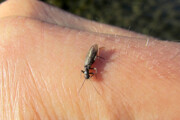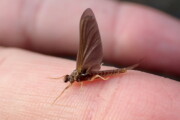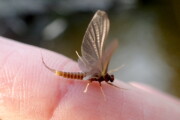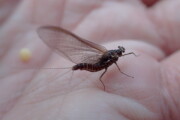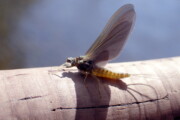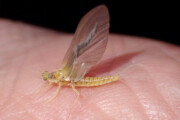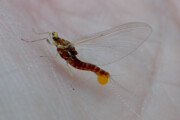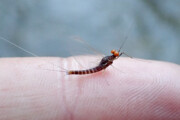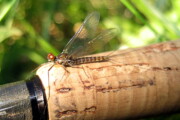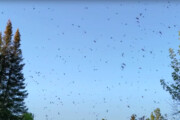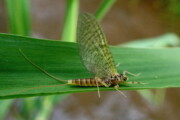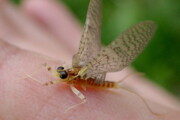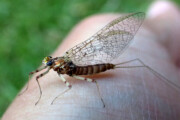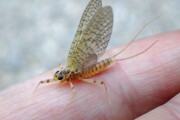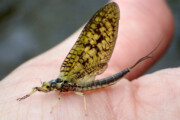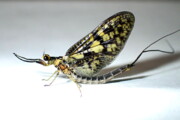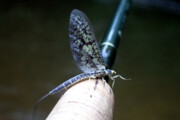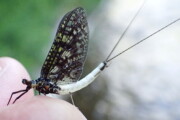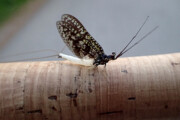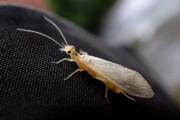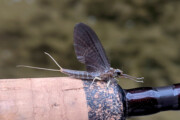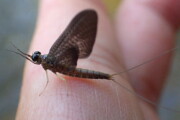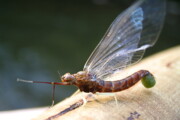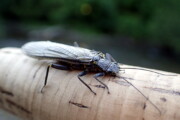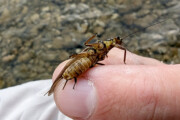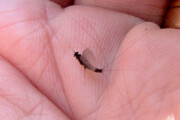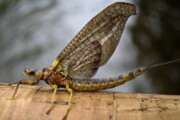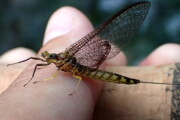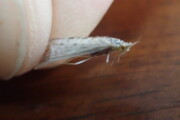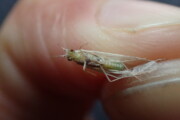Over the years, I’ve accumulated a collection of photos of various mayflies, stoneflies and caddisflies. The majority of these were captured from rivers in southern Ontario, most notably from the Credit River (my home river). That said, they should still be a good representation of the same bugs on different river systems in Ontario and even in other eastern provinces and states throughout Canada and the US. Keep in mind that there may still be some slight colour and size variations from one system to the other.
I’ve found these photos to be immensely helpful when choosing flies to represent the various insect hatches on our rivers – whether it be through developing / tying your own flies, purchasing flies, or simply picking the best match from your fly box.
Credit River Insects
Early Black Stonefly
Size: 16-18
Timing: April
Usually the first minor hatch of the season, often starting before trout opener. You won’t usually find the adults in large numbers and therefore can’t really count on them for reliable dry fly fishing. Small black stonefly nymphs are usually much more productive in early season.
Hendrickson
Size: 12-16
Timing: May
The first major hatch of the season that every trout angler looks forward to. Depending on the year, this can be a very good and thick hatch, bringing out some nice large browns to feed.
Sulphur (all variations)
Size: 14-18
Timing: May / June
The same family as the Hendrickson and very similar looking, it can be very difficult to tell these apart from Hendricksons due to the wide colour variation found among the different variants. Adults can range from yellow to olive to almost red. A small Hendrickson pattern will work fine to imitate the darker adults, but you should carry some flies to imitate the more typical yellow variant as seen in the first two images below. This hatch usually starts near the end of the Hendricksons and proceeds into June. On the Credit, you can often find blanket hatches of these (as seen below).
Grey Fox (March Brown)
Size: 12-14
Timing: End of May / Early June
Another major hatch on the Credit, trout will often key in on Grey Foxes heavily. In fact, this hatch usually overlaps the largest mayfly hatch of the season – the Green Drake – and there are times when both insects are on the water, but the trout are passing up on the much larger Green Drakes in favor of foxes. You need to have some of these in your fly box!
Green Drake Dun
Size: 8-10
Timing: Early June
It’s a good year when the Green Drakes are hatching in good numbers on the Credit. These mayflies, the largest found on the Credit, were almost completely eradicated from the system, but have made somewhat of a comeback in recent years. Still, they can be hit or miss. The duns have a distinct green and black coloration, much different from the spinners. Trout usually tend to key in on the duns a bit less than the spinners, but they can still bring out some huge browns! If they are around and the trout are feeding but refusing your fly, trying a Grey Fox (which usually overlaps this hatch) can sometimes change your luck.
Green Drake Spinner (Coffin Fly)
Size: 8-10
Timing: Early June
The molted spinner of the Green Drake, which isn’t green at all! This is probably the most unique looking mayfly out there. If you’re lucky, you’ll start to see them fluttering up in the trees above the river early in the evening, getting lower and lower as the evening progresses. Often, they won’t descend and start depositing their eggs until just before or after dark (if at all). This is easily the best fishing of the year if you’re lucky enough to be on the water when they’re thick, but it’s a very small window of opportunity.
Little Yellow Stonefly (Yellow Sally)
Size: 14-16
Timing: May / June
Easily recognizable and the first semi-productive stonefly hatch of the season, these yellow colored stoneflies tend to come and go during the end of May and throughout June (sometimes into July). When the trout get used to seeing them, they can be a handy prospecting dry fly to use when nothing else is happening. You’ll probably encounter a few evenings where not much else is happening but these on the water, so it’s a good pattern to have.
Spotted Sedge (Caddis)
Size: 14-16
Timing: May – July
You tend not to see a ton of caddis on the Credit, but it’s still good to have some tan or slightly darker caddis patterns just in case – as you will certainly see them on the water occasionally. This is in stark contrast with the close by Grand River, where the caddis get so thick that they will cover your waders. This is also another good prospecting pattern, as they are around for most of the spring and summer.
Isonychia
Size: 10-12
Timing: June – September
The Isonychia is by far the most consistent Credit River mayfly. These large reddish brown mayflies are around for almost the entire season and the Browns are almost always looking for these. These are largest earlier in the season, where they can be as a big as a size 10. They’ll often take a small break in the middle of the season and then pick back up later, but at a smaller size, usually between 12-14. When nothing else is going on, these hatches can save the day. The nymphs are also almost always in the river, so it’s good to have some of those on hand as well.
Golden Stonefly
Size: 8-10
Timing: June – July
The Credit has a pretty good population of these huge stoneflies and it’s wise to carry a bunch of imitations in your fly box. They are unmistakable when they’re flapping their wings on top of the water. This is another great prospecting fly once they have been on the river for a while, as the trout will often be looking for them. You might also run into a good number of them during warmer summer days. I would almost argue that this is the second most reliable pattern to fish on the Credit, due to both its size and prolonged presence. Don’t forget about carrying large stonefly nymphs as well, as there are lots of them in the river and they are super effective.
Trico
Size: 20-24
Timing: July – August
The smallest mayfly to frustrate (and occasionally bring joy to) many an angler. In late summer, you will sometimes find these on the water in good numbers either early morning or in the evening. I find they are more prominent in the brook trout waters above the cataract on the Credit – and some very good days on the water can be had if you happen to catch a good hatch. That is, if you can see well enough to tie them onto the end of your fly line!
Late Hex (Hexagenia Atrocaudata / Giant Drake)
Size: 8-10
Timing: August – September
Not to be confused with the larger Hexagenia Limbata (which is what most people think of when they hear “Hex”) – this is their later and smaller little sibling. You won’t find good hatches of these on a regular basis, but you might get lucky and catch them. They are huge meals and if they happen to be around, you can be they will be bringing out the largest fish in the river!
White Miller
Size: 12-16
Timing: Late August – September
This caddisfly shows up near the end trout season and is extremely easy to identify by its erratic behavior. They will be found swarming in circles just on top of the river late in the evening, usually just before dusk. They can be a blessing and a curse, as often they are the only adult insect around, but fishing with them can be hit and miss. That said, I’ve had plenty of nights where a good White Miller fly pattern has saved the day. Note that there is also a white mayfly that is sometimes referred to as “White Miller” – that is NOT this fly, as this one is the caddis.

